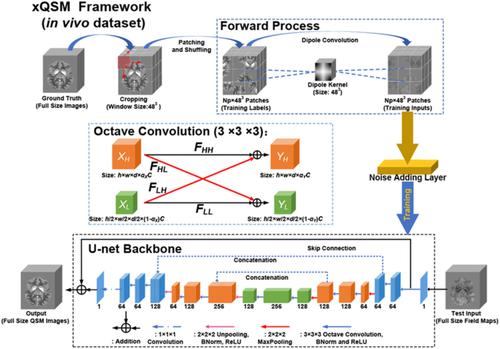当前位置:
X-MOL 学术
›
NMR Biomed.
›
论文详情
Our official English website, www.x-mol.net, welcomes your
feedback! (Note: you will need to create a separate account there.)
xQSM: quantitative susceptibility mapping with octave convolutional and noise‐regularized neural networks
NMR in Biomedicine ( IF 2.7 ) Pub Date : 2020-12-27 , DOI: 10.1002/nbm.4461 Yang Gao 1 , Xuanyu Zhu 1 , Bradford A Moffat 2 , Rebecca Glarin 2, 3 , Alan H Wilman 4 , G Bruce Pike 5 , Stuart Crozier 1 , Feng Liu 1 , Hongfu Sun 1
NMR in Biomedicine ( IF 2.7 ) Pub Date : 2020-12-27 , DOI: 10.1002/nbm.4461 Yang Gao 1 , Xuanyu Zhu 1 , Bradford A Moffat 2 , Rebecca Glarin 2, 3 , Alan H Wilman 4 , G Bruce Pike 5 , Stuart Crozier 1 , Feng Liu 1 , Hongfu Sun 1
Affiliation

|
Quantitative susceptibility mapping (QSM) provides a valuable MRI contrast mechanism that has demonstrated broad clinical applications. However, the image reconstruction of QSM is challenging due to its ill‐posed dipole inversion process. In this study, a new deep learning method for QSM reconstruction, namely xQSM, was designed by introducing noise regularization and modified octave convolutional layers into a U‐net backbone and trained with synthetic and in vivo datasets, respectively. The xQSM method was compared with two recent deep learning (QSMnet+ and DeepQSM) and two conventional dipole inversion (MEDI and iLSQR) methods, using both digital simulations and in vivo experiments. Reconstruction error metrics, including peak signal‐to‐noise ratio, structural similarity, normalized root mean squared error and deep gray matter susceptibility measurements, were evaluated for comparison of the different methods. The results showed that the proposed xQSM network trained with in vivo datasets achieved the best reconstructions of all the deep learning methods. In particular, it led to, on average, 32.3%, 25.4% and 11.7% improvement in the accuracy of globus pallidus susceptibility estimation for digital simulations and 39.3%, 21.8% and 6.3% improvements for in vivo acquisitions compared with DeepQSM, QSMnet+ and iLSQR, respectively. It also exhibited the highest linearity against different susceptibility intensity scales and demonstrated the most robust generalization capability to various spatial resolutions of all the deep learning methods. In addition, the xQSM method also substantially shortened the reconstruction time from minutes using MEDI to only a few seconds.
中文翻译:

xQSM:使用倍频程卷积和噪声正则化神经网络的定量磁敏度映射
定量磁敏度映射 (QSM) 提供了一种有价值的 MRI 对比机制,已证明具有广泛的临床应用。然而,QSM 的图像重建由于其不适定偶极反演过程而具有挑战性。在这项研究中,通过将噪声正则化和修改的八度卷积层引入 U-net 主干,设计了一种新的 QSM 重建深度学习方法,即 xQSM,并分别使用合成数据集和活体数据集进行训练。xQSM 方法与最近的两个深度学习(QSMnet +和 DeepQSM)和两种传统的偶极子反演(MEDI 和 iLSQR)方法,使用数字模拟和体内实验。评估重建误差指标,包括峰值信噪比、结构相似性、归一化均方根误差和深灰质敏感性测量,以比较不同方法。结果表明,所提出的用体内数据集训练的 xQSM 网络实现了所有深度学习方法的最佳重建。特别是,与 DeepQSM、QSMnet +相比,它使数字模拟的苍白球磁敏度估计的准确度平均提高了 32.3%、25.4% 和 11.7%,体内采集的准确度提高了 39.3%、21.8% 和 6.3%和 iLSQR,分别。它还对不同的敏感性强度尺度表现出最高的线性度,并展示了对所有深度学习方法的各种空间分辨率的最强大的泛化能力。此外,xQSM 方法还将重建时间从使用 MEDI 的几分钟缩短到仅几秒钟。
更新日期:2021-02-04
中文翻译:

xQSM:使用倍频程卷积和噪声正则化神经网络的定量磁敏度映射
定量磁敏度映射 (QSM) 提供了一种有价值的 MRI 对比机制,已证明具有广泛的临床应用。然而,QSM 的图像重建由于其不适定偶极反演过程而具有挑战性。在这项研究中,通过将噪声正则化和修改的八度卷积层引入 U-net 主干,设计了一种新的 QSM 重建深度学习方法,即 xQSM,并分别使用合成数据集和活体数据集进行训练。xQSM 方法与最近的两个深度学习(QSMnet +和 DeepQSM)和两种传统的偶极子反演(MEDI 和 iLSQR)方法,使用数字模拟和体内实验。评估重建误差指标,包括峰值信噪比、结构相似性、归一化均方根误差和深灰质敏感性测量,以比较不同方法。结果表明,所提出的用体内数据集训练的 xQSM 网络实现了所有深度学习方法的最佳重建。特别是,与 DeepQSM、QSMnet +相比,它使数字模拟的苍白球磁敏度估计的准确度平均提高了 32.3%、25.4% 和 11.7%,体内采集的准确度提高了 39.3%、21.8% 和 6.3%和 iLSQR,分别。它还对不同的敏感性强度尺度表现出最高的线性度,并展示了对所有深度学习方法的各种空间分辨率的最强大的泛化能力。此外,xQSM 方法还将重建时间从使用 MEDI 的几分钟缩短到仅几秒钟。











































 京公网安备 11010802027423号
京公网安备 11010802027423号